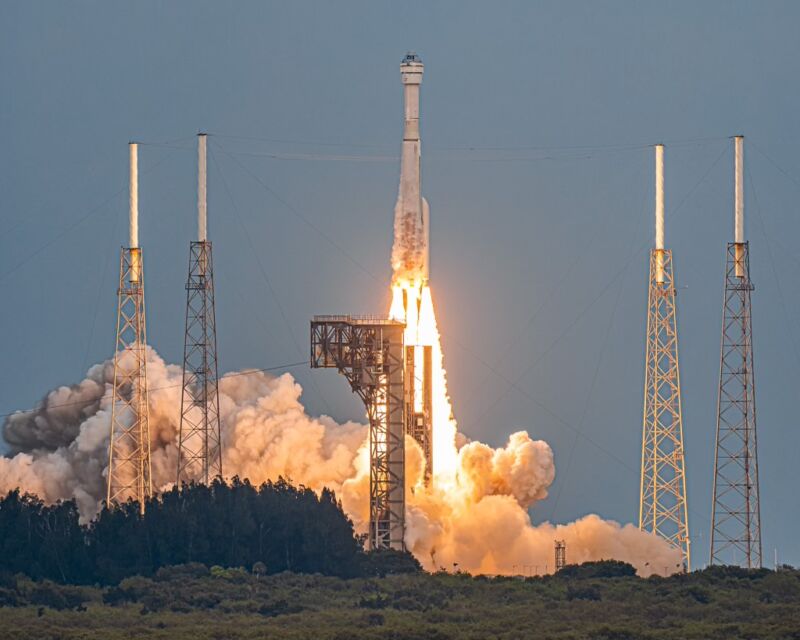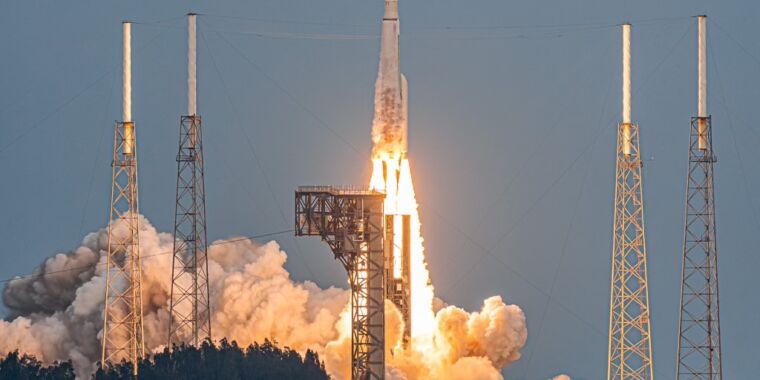
Trevor Mahlmann
Welcome to Edition 4.43 of the Rocket Report! Thanks for your patience last week with me for not putting out a newsletter—I’ve tried to reward it this week with an extra-long version. I would also like to extend our congratulations to Boeing, NASA, and United Launch Alliance on a successful launch of the Starliner spacecraft, and a good orbital insertion. Next comes a rendezvous and docking with the International Space Station on Friday.
As always, we welcome reader submissions, and if you don’t want to miss an issue, please subscribe using the box below (the form will not appear on AMP-enabled versions of the site). Each report will include information on small-, medium-, and heavy-lift rockets as well as a quick look ahead at the next three launches on the calendar.

Relativity Space completes stage tests. The California-based launch company announced this week that it has successfully completed a mission duty cycle test for its Terran 1 rocket’s second stage, running the full test duration (see video from the company’s test stage in Mississippi). Finishing this test means that the company believes that the upper stage, and all of its subsystems, are ready for flight. Relativity Chief Executive Tim Ellis has previously said he is highly confident that the Terran 1 rocket will make its debut launch from Florida this year.
First stage shipping soon? … The company also announced completion of “acceptance testing” for all nine of the Aeon 1 engines that will power the first stage of the Terran 1 rocket. Then, on Thursday, Ellis subsequently shared a photo showing the first stage undergoing a test firing in Mississippi. “Data review ongoing—all clean and this baby will be shipping to our launch site at Cape Canaveral,” Ellis wrote. It now seems possible that the Terran 1 will become the first rocket fueled by liquid oxygen and methane to reach orbit.
ABL Space does it, too. ABL Space Systems said Monday it has also completed acceptance testing of the second stage of its RS1 vehicle at its Mojave, California, test site. Success came four months after a previous version of the stage was destroyed in a test accident, Space News reports. The company has since shipped the stage to its launch site in Kodiak, Alaska. ABL is targeting “early summer” for the debut of its RS1 launch vehicle.
A learning experience … Dan Piemont, president of ABL Space Systems, told the publication that ABL used the January test anomaly as a “great opportunity” to demonstrate how quickly it can build and test a stage. The company built the stage itself in three weeks, followed by structural tests. The E2 engine, which had a “hard start” during the anomaly, went through its own tests before the integrated stage performed a four-week campaign of acceptance tests. The RS1 rocket is in the same class and price range as Relativity’s Terran 1, so it will be interesting to see who can execute as both companies get near to their first launch attempt. (submitted by Ken the Bin)
Virgin Orbit to add more carrier aircraft. The air-launch company has ordered two new modified cargo airframes to launch more rockets into space, CNBC reports. Virgin expects to take delivery of the first of the planes next year. Virgin Orbit CEO Dan Hart said the delivery timing of the second plane will be “driven more by market demand” for launches. The deal, he said, “eliminates one of the key chokepoints that we have in the system.” It should help as Virgin seeks to fly its LauncherOne rocket from horizontal launch sites in multiple countries.
Carrying two at a time … Hart declined to specify the financial details of the deal with L3Harris but noted that the upfront cost of a 747 airframe is in the “single digit millions.” Virgin Orbit’s new 747s will feature an improved layout, with L3Harris modifying the aircraft to carry up to two LauncherOne rockets, as well as all of the company’s ground support equipment, to a launch site. “[To have the] ability to deploy two rockets and all the ground equipment in one airplane, fly somewhere, set it up, and all of a sudden you’ve got a launch base somewhere is pretty unique,” Hart said. (submitted by Ken the Bin)
Chinese private launch fails. An orbital launch attempt by Chinese startup iSpace suffered failure early Friday following two failures last year, Space News reports. The fourth Hyperbola-1, a four-stage solid rocket, lifted off from the Jiuquan Satellite Launch Center in the Gobi Desert on May 13. Apparent launch footage appeared on a Chinese social media site shortly after launch, but a period of silence followed, extending well past when a similar launch could have been declared successful.
A checkered record … The failure was confirmed by Chinese state media Xinhua four hours after the launch. Beijing-based iSpace became the first Chinese company outside the state-owned traditional space sector to successfully launch a satellite into orbit in July 2019. However, the firm suffered two subsequent failures in February and August of last year. (submitted by Ken the Bin)
Most Rocket Lab revenue not coming from launch. In quarterly earnings released Monday, Rocket Lab reported $40.7 million in revenue for the first quarter of 2022, a net loss of $26.7 million, and an adjusted earnings (before interest, taxes, depreciation, and amortization loss) of $8 million, Space News reports. The earnings revealed a striking difference between the company’s two main lines of business: launch and space systems. That latter category, which includes its Photon spacecraft and components business, generated $34.1 million in revenue in the quarter. Launch provided only $6.6 million from a single Electron launch.
A launch a month … The company projects that revenue difference to continue in the second quarter, although not nearly as pronounced. The company forecasts $51 million to $54 million in revenue in the second quarter, with space systems generating $32 million to $35 million and launch $19 million. The launch revenue comes from three Electron launches scheduled for the second quarter, two of which have already taken place. The third is the Electron launch of NASA’s Capstone lunar smallsat mission, scheduled for the end of May.
Astra reveals plans for a larger rocket. Small launch company Astra revealed its new launch vehicle, which will be capable of carrying heavier payloads and flying more frequently, Space News reports. At its “Spacetech Day” event at its Alameda, California, headquarters, company executives offered some details about a new rocket called Rocket 4.0. The vehicle will be able to place up to 300 kilograms into low Earth orbit and 200 kilograms into Sun-synchronous orbit at a “base price” of $3.95 million. By contrast, Astra’s current Rocket 3.3 vehicle can accommodate a small fraction of that payload, having to date launched only a few cubesats at a time.
Engines that shall not be named … Chris Kemp, Astra’s chief executive, said the company estimates the average mass of satellites expected to launch over the next 10 years is 180 kilograms. “Our objective is to address the majority of the market for megaconstellation customers,” he said. The biggest change in the rocket is its first-stage propulsion. While Rocket 3.3 uses five of Astra’s Delphin engines, generating a combined 35,000 pounds-force of thrust, Rocket 4.0 will use two larger engines that produce a combined 70,000 pounds-force of thrust. The company did not name the new engines, which reportedly are being purchased from Firefly. (submitted by Ken the Bin and Tfargo04)
Critics of Georgia spaceport point to economic study. The battle over whether to build a vertical launch site for small rockets in coastal Georgia is continuing. After voters rejected Camden County’s request to purchase 4,000 acres for the spaceport, county officials have been moving ahead with private investors. All along they have cited the spaceport as a potential economic boon to the region. However, critics are now pointing to an economic assessment done for a similarly sized spaceport proposal in Michigan, The Current reports.
Not a good investment? … The nonprofit IQM Research Institute completed a spaceport feasibility study for the Michigan Aerospace Manufacturers Association in February 2021 and concluded that the annual revenue generated from launching a rocket once a week in Michigan would be the same as that of two additional fast-food chain restaurants. “Currently, US public-private partnership spaceports that are not subsidized by state or federal funding are struggling to remain economically viable,” the study concluded. (submitted by zapman987)
Gilmour Space tests Phoenix rocket engine. The Australian launch company is developing the three-stage Eris rocket, which may make its debut launch as early as this year from a spaceport in north Queensland. This week the company said it had completed a successful 190-second mission duty cycle test of the Phoenix engine that will power its third stage. Video of the LOX-kerosene engine test can be seen here.
Working toward orbit … The first and second stages of Eris will be powered by a larger hybrid rocket engine, Sirius, which is undergoing qualification tests. “The team has done exceptionally well to design, build, and test this new engine in just over a year while also scaling our main hybrid rocket engine,” said Gilmour Space CEO Adam Gilmour. We’re far from sure that Eris will launch this year, but the company seems to be taking credible steps toward an orbital launch reasonably soon.
Orbex unveils prototype rocket. On Wednesday, May 11, British launch company Orbex revealed what it declared to be a “prototype” of its Prime orbital rocket. “This is a major milestone for Orbex and highlights just how far along on our development path we now are,” said Chris Larmour, CEO of Orbex. “From the outside, it might look like an ordinary rocket, but on the inside, Prime is unlike anything else. To deliver the performance and environmental sustainability we wanted from a 21st century rocket we had to innovate in a wide number of areas.” These include low-carbon fuels, 3D-printed rocket engines, and lightweight fuel tanks.
How real is the rocket? … The Prime rocket will launch from Space Hub Sutherland, a new spaceport being constructed on the north coast of Scotland. The company says it intends to launch the rocket before the end of this year. It’s not clear how much work the word “prototype” is doing in the description of this vehicle. For example, are there flight engines on the vehicle? Are the tanks qualified? Are there any avionics inside? Is the flight software ready? Is that a real second stage? (submitted by markmuetz, Tfargo04, Ken the Bin, and EllPeaTea)
Phantom Space targeting 2023 for orbital launch. Regarding development of the Daytona small launch vehicle, Phantom CEO Jim Cantrell told Payload: “We see no blockage getting to orbit next year.” The company recently placed an order for more than 200 Hadley rocket engines from Ursa Major that it will use to power Daytona and other launch vehicles under development.
Funding going well … Cantrell and his cofounders optimized for capital efficiency, he said, “because we thought we’d have a hell of a time raising money. I thought the markets were tapped out on launch. I was so wrong on that, as wrong as you get.” Cantrell has previously talked a big game with Vector Launch, which flamed out. We certainly hope a better fate awaits Phantom Space. (submitted by Ken the Bin)

Starliner successfully reaches orbit. It has been 29 months since Boeing’s Starliner spacecraft first took flight on a demonstration mission that failed to reach the International Space Station. On Thursday, the vehicle is ready to try again, Ars reports. At the appointed time Thursday evening, the Atlas V rocket carrying the Starliner spacecraft lifted off from Cape Canaveral Space Force Station in Florida. After the rocket dropped the Starliner spacecraft off at an altitude of 181 km, the spacecraft’s on-board propulsion system took over, raising Starliner into a stable, circular orbit. The next big milestone is docking with the International Space Station on Friday evening.
The stakes are high for both Boeing and NASA … There is a high likelihood that Boeing has now lost money developing Starliner over the last decade. Recently, former NASA Deputy Administrator Lori Garver said she believed the company probably would not undertake the program if it had a chance to do it all again. The sooner Boeing can get Starliner into an operational status, therefore, the better it will be financially, as it can serve both NASA as well as bring on additional private-market customers. The space agency, meanwhile, would very much like a second means of reaching the space station.
SpaceX valuation continues to soar. SpaceX is poised to become the most valuable US startup as its valuation rose to over $125 billion in an ongoing share sale in the secondary market, Reuters reports. The shares, worth about $72, jumped in valuation from last October, when SpaceX’s shares were sold at $56 apiece after a 10-1 split. At the time, the company was valued at $100 billion.
Launching ahead of Stripe … No new shares have been issued in the secondary offering, but the company indicated to investors that it may do so later this year, said one of the sources, who asked not to be identified. The share sale could value SpaceX at over $125 billion, surpassing fintech giant Stripe, which was valued at $115 billion in a secondary sale. It’s not clear whether founder Elon Musk is among the share sellers.
India tests human-rated booster. The Indian space agency, ISRO, said it has successfully completed a static-fire test of a human-rated solid rocket booster for the Gaganyaan human spaceflight program. The test, at the Satish Dhawan Space Centre in Sriharikota, verified the S200 rocket booster that will be attached to the GSLV Mk III satellite launch vehicle for human spaceflights.
Spooling up for human missions … To qualify this rocket for astronaut launches, the GSLV Mk III underwent a host of design improvements aimed at increasing the safety and reliability of various systems. For the S200 booster, this included additional safety features for motor case joints and robust insulation and ignition systems. Two uncrewed test flights of the Gaganyaan capsule are scheduled for 2023 before the first human mission. (submitted by EllPeaTea and Ken the Bin)

NASA extends Artemis I launch dates into next year. NASA has published a list of potential launch dates for the Artemis I mission, starting as early as July 26 and running through June of next year. During this time period, due to various constraints, the space agency has preliminarily identified 158 launch opportunities, Ars reports. The Artemis I mission will encompass the debut launch for NASA’s large Space Launch System rocket and the second orbital flight of its Orion spacecraft. Depending on when the uncrewed demonstration mission launches, it could last from 26 to 42 days as Orion flies into a distant retrograde orbit around the Moon.
Slow your roll … In its news release, NASA helpfully explains the various constraints behind these dates, including orbital mechanics. NASA said not to read too much into the inclusion of 2023 dates, however. “The range of dates is not meant to convey anything about the probability of launching in 2022 or 2023,” Kathryn Hambleton, a NASA spokeswoman, told Ars. “All launch dates more than about two months out are preliminary. It is standard for the team to have a preliminary outlook several months ahead. We’ll set a more specific target after we complete wet dress rehearsal testing.” It looks like the next wet dress test attempt will now come no earlier than mid or late June. (submitted by Ken the Bin)
SpaceX is blowing up Raptors in Central Texas. The good people at NASASpaceflight.com have set up cameras to cover the major test sites at SpaceX’s engine and stage testing facility in McGregor, Texas (you can watch “McGregor Live” at any time). The cameras have been operating for more than a month, and in a new video Das Valdez explains what they’ve observed so far as SpaceX uses multiple horizontal and vertical test stands as part of the Raptor rocket engine development program.
Two engines lost … According to Valdez, there are an average of three Raptor tests a day, but the company has done as many as eight Raptor firings in a single day. During dozens of long-duration tests over the last month there have been two RUDs, or Rapid Unscheduled Disassemblies. However, it’s possible that these failures were intentional, as engineers pushed the engines beyond their theoretical limits. In any case, the failures probably should not be seen as an overly big deal as SpaceX continues to iterate on Raptor’s design and push its performance to, and beyond, design limits. “Just the fact that they have so many engines to test is pretty impressive,” Valdez said.
Next three launches
May 20: Long March 2C | Classified payload | Jiquan, China. | 10:30 UTC
May 25: Falcon 9 | Transporter 5 | Cape Canaveral, Fla. | 18:35 UTC
June 3: Soyuz | Progress 81P | Baikonur Cosmodrome, Kazakhstan | 09:23









